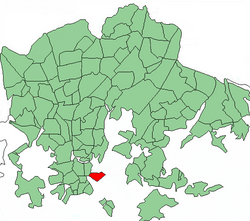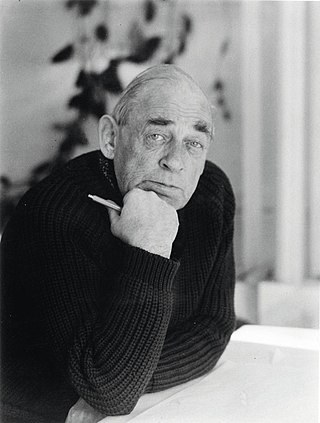
Hugo Alvar Henrik Aalto was a Finnish architect and designer. His work includes architecture, furniture, textiles and glassware, as well as sculptures and paintings. He never regarded himself as an artist, seeing painting and sculpture as "branches of the tree whose trunk is architecture." Aalto's early career ran in parallel with the rapid economic growth and industrialization of Finland during the first half of the 20th century. Many of his clients were industrialists, among them the Ahlström-Gullichsen family, who became his patrons. The span of his career, from the 1920s to the 1970s, is reflected in the styles of his work, ranging from Nordic Classicism of the early work, to a rational International Style Modernism during the 1930s to a more organic modernist style from the 1940s onwards.

Helsinki is the capital and most populous city in Finland. It is located on the shore of the Gulf of Finland and serves as the seat of the Uusimaa region in southern Finland. Approximately 675,000 people live in the municipality, with 1.25 million in the capital region, and 1.58 million in the metropolitan area. As the most populous urban area in Finland, it is the country's most significant centre for politics, education, finance, culture, and research. Helsinki is situated 80 kilometres (50 mi) to the north of Tallinn, Estonia, 360 kilometres (220 mi) to the north of Riga, Latvia, 400 kilometres (250 mi) to the east of Stockholm, Sweden, and 300 kilometres (190 mi) to the west of Saint Petersburg, Russia. Helsinki has significant historical connections with these four cities.

Aino Maria Marsio-Aalto was a Finnish architect and a pioneer of Scandinavian design. She is known as the design partner of architect Alvar Aalto, with whom she worked for 25 years, and as a co-founder with him, Maire Gullichsen, and Nils-Gustav Hahl of the design company Artek, collaborating on many its most well-known designs. As Artek's first artistic director, her creative output spanned textiles, lamps, glassware, and buildings. Her work is in the permanent collection of the Museum of Modern Art (MoMA) in New York, and MoMA has included her work in nine exhibitions, the first of which was Aalto: Architecture and Furniture in 1938. Other major exhibitions were at the Barbican Art Gallery in London and Chelsea Space in London. Aino Aalto has been exhibited with Pablo Picasso.

Sörnäinen is a neighbourhood in the city of Helsinki, Finland.
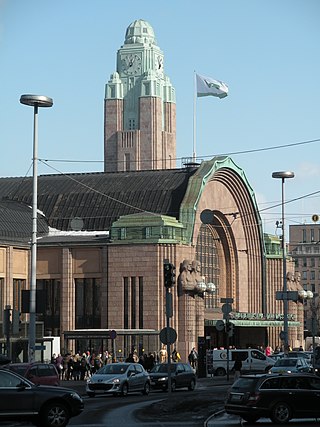
Helsinki Central Station (HEC) is the main station for commuter rail and long-distance trains departing from Helsinki, Finland. The station is used by approximately 400,000 people per day, of whom about 200,000 are passengers. It serves as the terminus for all trains in the Helsinki commuter rail network, as well as for all Helsinki-bound long-distance trains in Finland. The Rautatientori metro station is located in the same building.

The Market Square is a central square in Helsinki, Finland. It is located in central Helsinki, at the eastern end of Esplanadi and bordering the Baltic Sea to the south and Katajanokka to the east. HSL maintains a year-round ferry link from Market Square to Suomenlinna, and in the summer there are also private companies providing ferry cruises, both to Suomenlinna and to other nearby islands. The Presidential Palace, Helsinki City Hall, Swedish Embassy and the Stora Enso Headquarters building are all located adjacent to Market Square.

Uspenski Cathedral is a Greek Orthodox or Eastern Orthodox cathedral in Helsinki, Finland, and main cathedral of the Orthodox Church of Finland, dedicated to the Dormition of the Theotokos. Its name comes from the Old Church Slavonic word uspenie, which denotes the Dormition. It is the largest Greek Orthodox church in Northern Europe.
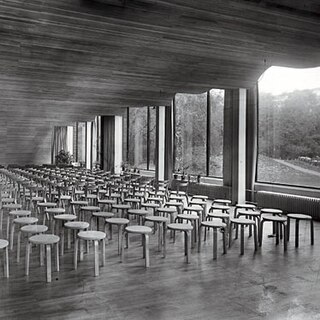
The architecture of Finland has a history spanning over 800 years, and while up until the modern era the architecture was highly influenced by Sweden, there were also influences from Germany and Russia. From the early 19th century onwards influences came directly from further afield: first when itinerant foreign architects took up positions in the country and then when the Finnish architect profession became established.

The Säynätsalo Town Hall is a multifunction building complex, consisting of two main buildings organised around a central courtyard: a U-shaped council chamber and town hall with administrative offices, and a community library with flats. The Town Hall was designed by Finnish architect Alvar Aalto for the municipality of Säynätsalo in Central Finland. Aalto received the commission after a design contest in 1949, and the building was completed in December 1951.

South Harbour is a bay and harbour area immediately next to the centre of the city of Helsinki, Finland. 4.7 million passengers in liner traffic and some 37 000 international cruise passengers travel through it every year. Also over million tonnes of unitized cargo passes through the South Harbour. Most of the harbour's traffic is to Stockholm, Sweden and Tallinn, Estonia, and cruises. In summertime, there is also much small ship traffic. During the winter time, excess snow from snow removal may be disposed of in the harbor. As of 2020, the Carmel, an old vessel, was keeping the harbor open by circling 400 times within 24 hours.
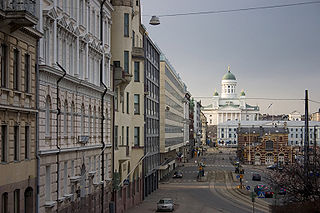
Kaartinkaupunki is a neighbourhood in the southern part of Helsinki, Finland.

Jätkäsaari is a peninsula and a quarter in Helsinki, the capital city of Finland. It is part to the Kampinmalmi district and Länsisatama neighbourhood. It was the site of the main container harbour in Helsinki until late 2008, when the harbour moved to the new facilities in Vuosaari. The terminals for passenger ferries to Tallinn and Saint Petersburg remain in Jätkäsaari at the West Harbour.

The Norrmén house, also known as the Norrmén castle and palace, was a red brick residential house representing the neo-renaissance architecture, situated for 63 years in Katajanokka, Helsinki, Finland, opposite the Uspenski Cathedral. It was designed by architect Theodor Höijer for the chairman of the Helsinki city council, Alfred Norrmén, who ordered the building plans from Höijer in 1896.

Rainer Mahlamäki is a Finnish architect, president of the Finnish Association of Architects (SAFA) from 2007 to 2011, Professor of Contemporary Architecture at the University of Oulu, and joint partner with Ilmari Lahdelma of the Helsinki-based architecture firm Lahdelma & Mahlamäki Architects, one of the most prolific such firms in Finland. A significant part of their work started as entries in architectural competitions, in which they have received 35 first prizes.
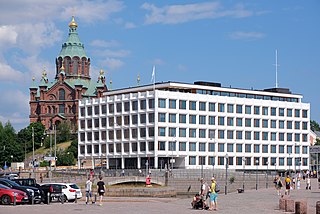
The Stora Enso headquarters is an office building located in the Katajanokka neighbourhood of central Helsinki, Finland, completed in 1962. It is notable for having been designed by the Finnish architect Alvar Aalto.

Greta Skogster was a Finnish textile artist, notable as the leading designer of the 1930-40s and a pioneer of modern textile design in Finland.

Katajanokka Terminal is a ferry terminal located in Katajanokka, in the Southern Harbor of Helsinki, Finland. The shipping company Viking Line operates scheduled services from the terminal to Stockholm and Tallinn.

The Turku barracks was a barracks building for the military of Russia built in 1833 in Kamppi, Helsinki, Finland, along the street Läntinen Henrikinkatu.
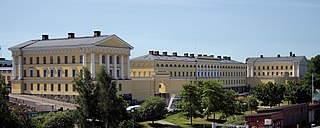
Merikasarmi is a barracks building in Katajanokka, Helsinki, Finland, originally built for the military of the Empire of Russia from 1816 to 1820, which currently houses the premises of the Ministry for Foreign Affairs in Finland. The barracks was designed by Carl Ludvig Engel. Before the Foreign Ministry moved to the area in the late 1980s the buildings were renovated and partly rebuilt according to the plans of Professor of Architecture Erik Kråkström.

Sompasaari is an island on the Kruunuvuorenselkä water area in the Sörnäinen district in Helsinki, Finland. On the southern side of the Nihdinkanava channel built in the middle of Sompasaari is the island of Nihti.
